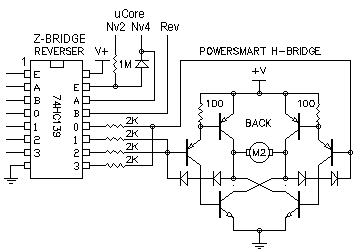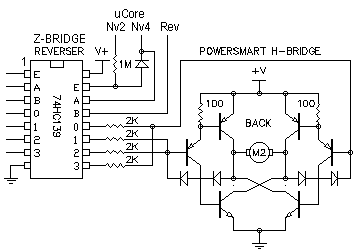
The Z-bridge

The total cost will be approximately US$10, which will save space on the circuit board. The design is efficient, but space constraints and budget considerations are a concern. It is possible to eliminate all transistors and resistors if the motors do not draw excessive current. Only a 74F139 or 74S139 chip is required, excluding the LS version. This chip can deliver peak currents up to 10mA for brief periods (less than 1 second) and can only supply one output at a time under normal operating conditions. The extent of operational limits in this configuration is uncertain. While the design is straightforward, it effectively conveys the intended functionality.
The proposed circuit design focuses on optimizing component usage and minimizing costs while maintaining functionality. The use of the 74F139 or 74S139 chip is critical, as it is capable of handling the necessary logic operations without the additional complexity of transistors and resistors, provided that the motors connected do not exceed the current limits. The choice of the 74F139/S139 over the LS version is essential due to its higher speed and lower power consumption characteristics.
In this configuration, the chip operates in a way that allows for the control of multiple outputs, albeit one at a time, which is sufficient for many applications where sequential control is acceptable. The chip's ability to deliver peak currents of 10mA for short durations indicates that it can handle transient loads effectively, making it suitable for applications where brief bursts of current are required without overheating or damaging the circuit.
When designing the circuit board, careful consideration should be given to the layout to ensure that the chip is adequately supported by power and ground connections, minimizing the potential for noise and ensuring reliable operation. Additionally, it is advisable to include bypass capacitors close to the power pins of the chip to stabilize the voltage supply during peak current demands.
Overall, this design emphasizes simplicity and cost-effectiveness while ensuring that the essential functionalities are retained, making it suitable for applications where budget constraints and space limitations are critical.Altogether it will cost about US$ 10 and much room on my circuit board. The design is really great but i don`t have to room for it and i like to spend less. You can drop all off the transistors and resistors if your motors don`t drain too much current. You only need a 74F139 or 74S139 NOT the LS version. The chip can provide peak currents up to 10 0mA for a short time (<1 second) and to one output at a time. This is for normal connections. I don`t know how far you can go with this misbehavior. It`s nothing special, but you get the idea how it is done. 🔗 External reference
The proposed circuit design focuses on optimizing component usage and minimizing costs while maintaining functionality. The use of the 74F139 or 74S139 chip is critical, as it is capable of handling the necessary logic operations without the additional complexity of transistors and resistors, provided that the motors connected do not exceed the current limits. The choice of the 74F139/S139 over the LS version is essential due to its higher speed and lower power consumption characteristics.
In this configuration, the chip operates in a way that allows for the control of multiple outputs, albeit one at a time, which is sufficient for many applications where sequential control is acceptable. The chip's ability to deliver peak currents of 10mA for short durations indicates that it can handle transient loads effectively, making it suitable for applications where brief bursts of current are required without overheating or damaging the circuit.
When designing the circuit board, careful consideration should be given to the layout to ensure that the chip is adequately supported by power and ground connections, minimizing the potential for noise and ensuring reliable operation. Additionally, it is advisable to include bypass capacitors close to the power pins of the chip to stabilize the voltage supply during peak current demands.
Overall, this design emphasizes simplicity and cost-effectiveness while ensuring that the essential functionalities are retained, making it suitable for applications where budget constraints and space limitations are critical.Altogether it will cost about US$ 10 and much room on my circuit board. The design is really great but i don`t have to room for it and i like to spend less. You can drop all off the transistors and resistors if your motors don`t drain too much current. You only need a 74F139 or 74S139 NOT the LS version. The chip can provide peak currents up to 10 0mA for a short time (<1 second) and to one output at a time. This is for normal connections. I don`t know how far you can go with this misbehavior. It`s nothing special, but you get the idea how it is done. 🔗 External reference
